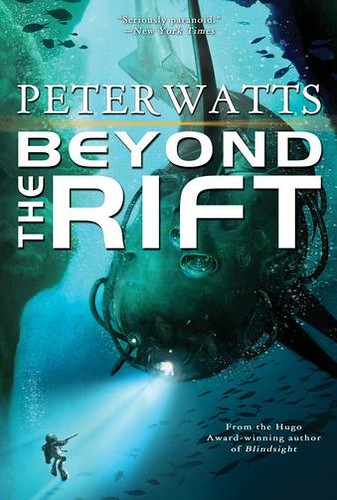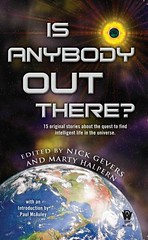I'm quite a cheerful guy in person. Apparently people are surprised by this.I don't know what they were expecting....But insofar as I'm known at all, I seem to be known as The Guy Who Writes The Depressing Stories....While mulling over what to put in this essay I did a quick Google search for the descriptors commonly applied to my writing. I list a few for illustrative purposes:BrutalDark (frequently "unrelentingly" so)ParanoidNightmarishRelentlessThe blackest depths of the human psycheUglySavageMisanthropicDystopian
 |
| Cover art by Hugh Sicotte |
So writes Peter Watts, in the afterword, entitled "Outtro: En Route to Dystopia with the Angry Optimist," to his forthcoming short story collection, Beyond the Rift .
.
As to Peter's opening sentence above, often readers confuse the writer with their writing. Though authors often call upon personal experiences in their writing, it certainly doesn't mean that the writer him/herself is in any way the protagonist in their stories. That's why these stories are called fiction.
If you've not previously read the works of Canadian science fiction writer Peter Watts, indeed, you are in for a treat.
Take, for example, the story "The Things," an homage to the classic science fiction movie, told from the creature's point of view. Then there is the story "The Island," in which a mother and son and an AI called "Chimp," aboard the generation ship Eriophora, must deal with a close encounter in the far reaches of space. "The Things" (originally published in Clarkesworld #40, January 2010) won the Shirley Jackson Award for best short story, and "The Island" (originally published in The New Space Opera 2, edited by Gardner Dozois & Jonathan Strahan, HarperCollins) won the Hugo Award for best novelette. In fact, Watts's stories and novels have been nominated for numerous awards, including the Hugo Award, the Theodore Sturgeon Award, the Campbell Award, the Locus Award, and the BSFA Award, among others -- and some of these awards more than once.
Beyond the Rift was my most recent project for publisher Tachyon Publications -- a copy editing job that I had been looking forward to since I first learned of the project earlier this year.
Watts's stories are all so well written that it is difficult to pick a favorite story. I think my favorite is "A Niche" (originally published in Tesseracts 3, edited by Candas Jane Dorsey & Gerry Truscott, Porcépic Books) because, well, because we all need our own space, our own personal niche -- even if it just happens to be below three kilometers of ocean; and we're all a little bit weird in our own unique way, aren't we? But then again, if you asked me next week what my favorite story is I could very well select a different one: maybe "Ambassador" (originally published in Ten Monkeys, Ten Minutes, EDGE Science Fiction and Fantasy Publishing), which is sort of like the car chase in The French Connection but with spaceships jumping across interstellar space.
In "Outtro," we also learn a bit about Peter Watts the person. He shares with us his run in, in December 2009, with U.S. border guards at the U.S.-Canadian border, upon returning home from a visit with friends in Nebraska. The outcome -- which prohibits Peter from ever again entering the United States -- most certainly contributes to his dystopian outlook in his writing.
You can read "The Things" online courtesy of Clarkesworld Magazine. After which, I hope you'll be adding Beyond the Rift to your online shopping cart. The book will be published on November 1.
to your online shopping cart. The book will be published on November 1.



